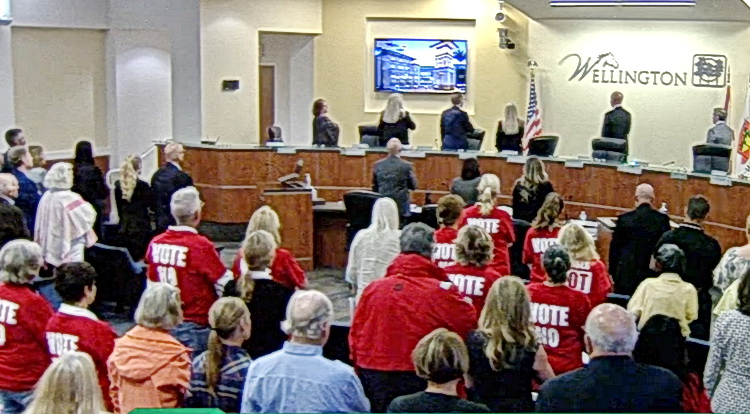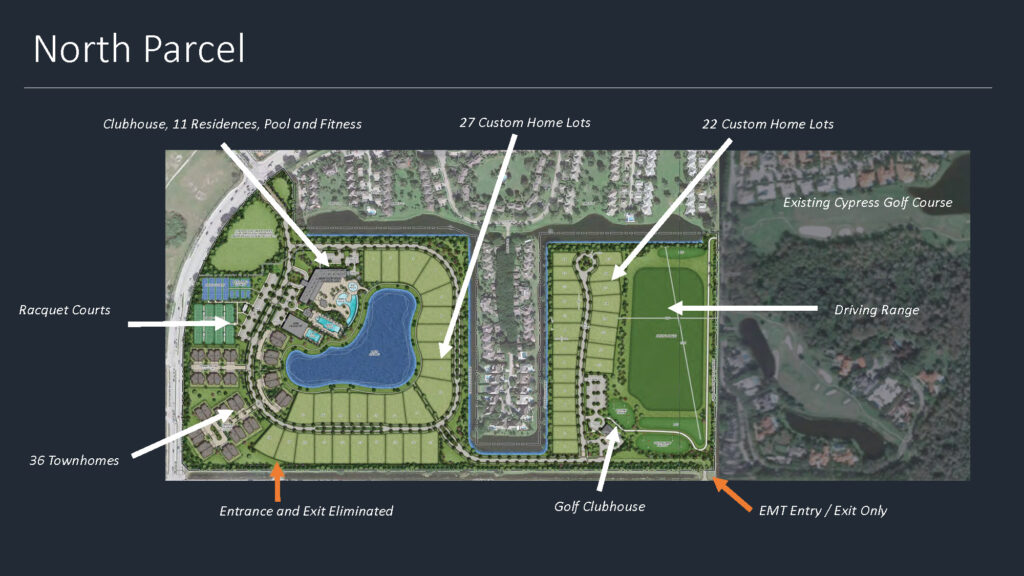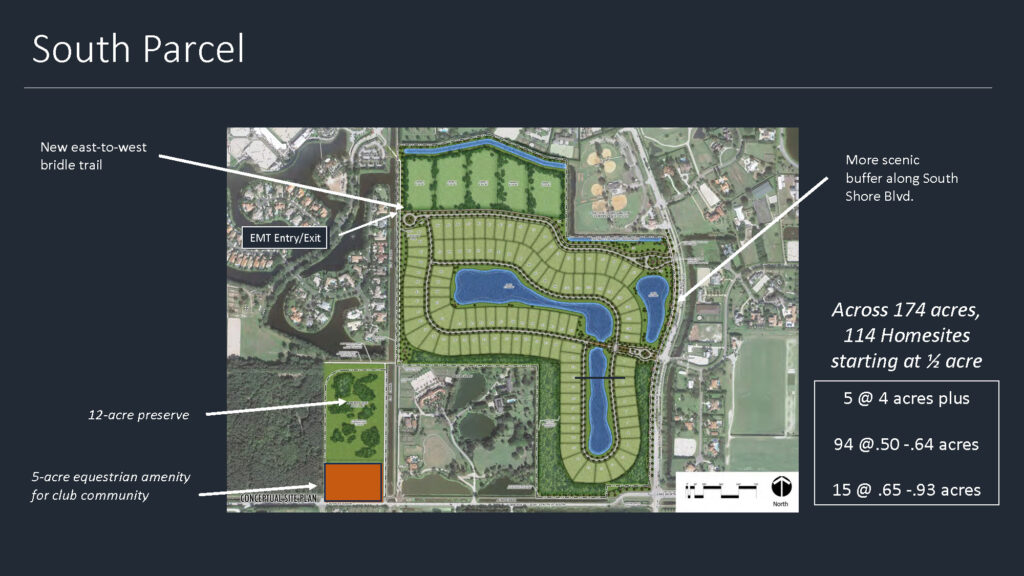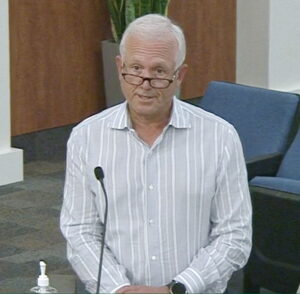They wore red T-shirts with white lettering that said “Vote No,” part of an overflow crowd which showed up for the Wellington, Florida, Village Council’s five-hour Tuesday night meeting on development plans that would affect the equestrian community.
The council drew no conclusions at the meeting, which will continue Wednesday evening. The session drew prominent figures in the horse world to speak on both sides of Wellington Lifestyle Partners’ plans for developing an expansion of the cramped Wellington International showgrounds. It is linked to taking more than 96 acres out of the Equestrian Preserve so WLP can build housing on a nearby parcel that now hosts dressage shows at Equestrian Village. In order for a property to be removed from the Preserve, four of the five council members must vote in favor.
This has been a long-running saga. It began when Mark Bellissimo, managing partner of Wellington Equestrian Partners, a major landholder in the village, announced his plans for the Wellington 3.0 development in 2022.
That went nowhere, and this year, a new iteration of his vision emerged under the banner of Wellington Lifestyle Partners, with Bellissimo stepping back and Doug McMahon taking over as WLP’s CEO. The plans for development were christened “Wellington North” for what is now the site of the dressage shows, and “Wellington South,” where the nearby showgrounds used by the Winter Equestrian Festival of hunters and jumpers would expand.
McMahon, managing director of developer The Tavistock Group and co-founder of the Nexus Luxury Collection, kicked off Tuesday’s meeting by offering a mea culpa, saying WLP’s original plan was “too grand.”
He explained, “Honestly, we were too big; we were too bold. I think we got it wrong.”
The application originally had too many condominiums and was too dense, he said, and what would happen with the showgrounds was “confusing.” A case in point was that several people who spoke to the council Tuesday night came up with different figures for how much land actually would be added to the existing showgrounds under the expansion plan.
A series of revisions by WLP has reduced the amount of housing to be built, from 447 to 210 units, and removed a number of condo buildings, coming up with plans that are “greener, more open.” But most important, WLP “has taken responsibility for a new showgrounds” that would include “a new home for dressage” and a new derby field on Wellington South, McMahon said. WLP will manage the funding and pay an estimated $25 million to $30 million toward building the showgrounds.
Although originally the parent company of Wellington International was going to buy the land and build the showgrounds, if all the approvals are in order, WLP will be building the showgrounds and leasing the facility to Wellington International. Since the showgrounds expansion concept surfaced, the economic climate has changed and financing is difficult
If WLP does not fulfill what is known as “Condition Seven,” McMahon said, “we do not get to build houses. It’s clear—a new showgrounds first, then we get to build houses.”
Most of the evening was taken up by comments from “interested parties,” representing residents with a stake in the community. There are those who worry that allowing a housing development on even a small portion of the village’s 9,000 Equestrian Preserve acres would open the door to other developers taking more land from the preserve.
Jane Cleveland, chair of the village’s Equestrian Preserve Committee that unanimously voted against taking land from the Preserve for development, wondered how you say yes to one developer “and no to the next.”
She called the development plans “the first domino. It’s not just 96 acres, it’s the first 96 acres,” cautioning that a precedent would be set for more property to be removed subsequently, she contended, comparing the possible future to what happened in now highly developed Boca Raton, south of Wellington.
The “Horses not Houses” movement has gathered more than 7,000 signatures on a petition against the WLP project. Residents campaigning against it, like those in “Vote No” T-shirts, see the proposed development as a threat to the equestrian ambience that makes Wellington “The Winter Equestrian Capital of the World.”
Prior to the meeting, WLP spokesperson Juliana Ferre explained to me that “If the residential units in our application are not granted on the North Parcel it simply does not make economic sense to give up the residential development rights we have on Pod F (Wellington South) in addition to the incremental investment of approximately $25mm+ in new equestrian facilities that we are committing to build on Pod F.”
The prominent Jacobs family, which owns Deeridge Farms just down Pierson Road from Equestrian Village, has previously clashed with Bellissimo. They were represented at the meeting by land use attorney Harvey Oyer, who revealed the family is “cautiously neutral” on the application, which had its first reading Tuesday.
Oyer noted that even so, his clients had “significant concerns that these applications threaten the character of Wellington’s equestrian community and the Jacobs family remains reluctant to support proposals, even though it is clear that the applicant has not only heard our concerns, but also adjusted their applications to address many of the concerns.”
The way that traffic would be affected by Wellington North is another question raised by the Jacobs.
The family does, however, support such concessions as presentation of more detailed plans for horse show grounds improvements, conditions that require they be completed in five years and “most importantly,” prior to any development or construction, Oyer reported. The family will continue to monitor the project so it can determine before the second reading if the project is in the best interests of the village of Wellington.
He said the Jacobs also want to see the Equestrian Village and adjacent White Birch parcel in the Preserve revert to their current restrictions if “the horse show improvements are not completed as represented” by the end of 2028. That land is privately owned, and even without taking it from the Preserve, a certain amount of building would have to be allowed there.
Oyer also mentioned “the history of failed promises by parties affiliated with the applicant has left our community feeling victimized time and time again. So the skepticism from our community is easy to understand as there have been too many empty promises and incomplete projects in the past.”
Others who spoke mentioned problems at the Tryon, N.C., International Equestrian Center, another Bellissimo project where a planned hotel never was built and elements of the facility were left unfinished when it hosted the 2018 FEI World Equestrian Games.
Former U.S. Equestrian Federation President Murray Kessler, a 47-year resident, pointed out, “Many of the great facilities and developments (in Wellington) faced various levels of resistance” before becoming an important part of the community.
He smiled when he said Bellissimo could be “a pain in the butt,” but added he had to “give credit where credit is due.” For one thing, investments directed by Bellissimo “put U.S. dressage on the map,” he mentioned. Bellissimo holds all but one of the licenses for the dressage shows held at Equestrian Village.
Explaining that the Wellington International horse show grounds are overcrowded and “sometimes unsafe,” Kessler said there was a danger that the facility could become landlocked with no room for expansion. He feels the process has worked as it is supposed to in refining the application.
Although he objected to the original proposal, WLP has stepped up with major concessions to produce a “win/win proposal.” And, he pointed out, “Doug McMahon is not Mark Bellissimo.”
Lynda Farrington, mother of world number three-ranked show jumper Kent Farrington, and Robin Parsky, who owned several horses ridden by Kent, are concerned about loss of the grass derby field at Equestrian Village, which was part of the original polo development.
“This is not replaceable,” Parsky said of the deep-rooted grass, an asset vital for training top international horses to compete at such celebrated grass fields as those at Aachen, Germany, and Spruce Meadows in Canada, she maintained, calling it “priceless.”
Lynda Farrington told the council, “We feel you’re turning your backs on us. We don’t need more houses; we don’t want to become Royal Palm Beach.”








